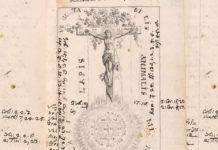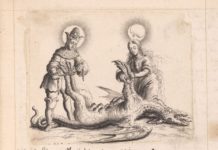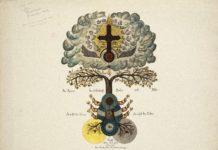A Community Project from Pansophers.com
Dear Rosicrucian readers,
A few weeks ago Pansophers launched a public project in our Facebook group. We called upon the community to join together and study some symbols. The symbols in question are the Rosicrucian Emblems of Daniel Cramer from 1617, which is quite early in our Rosicrucian Tradition.
We proposed this as a community project because people see things differently and that has value. We decided that we’d allow everyone to comment and to share their thoughts on the emblem to help unveil its deeper meaning. The project so far has been a success!
We saw more than 200 comments on the first emblem. Pansophers author, Bro Teike van Baden, helped coordinate the project and did the hard work of collecting what everyone said within one document. Samuel Robinson then produced the article below based on everyone’s thoughts.
We are going to do two things with this series.
Firstly, we are going to study all 40 of the original Rosicrucian heart emblems in the same way. We are going to publish them all on the blog for free. YOU the reader get the full symbolism articles.
Secondly, we are going to compile the final versions of the articles into one small booklet. The booklet will contain some additional mystical exercises based on the Pansophers tradition of Alois Mailander. Here the letters of the mystical keyword of each emblem will be awakened in the body.
The booklet will be priced at just $12.00 and the final version will be provided in this final booklet form for those who wish to make a small donation to support this blog. Seeing the costs of running this blog are acuminating, we thought why not have a small-book for those who wish to make a donation?
The approach to combine the Rosicrucian letter mysticism of the old time German Pansophic Order has never been applied to these symbols. Yet the letter mysticism now known thanks to this article from Richard Cloud helps enrich the process of meditating upon these symbols.
For the most part, those wishing to work with Cramer’s Rosicrucian Emblems have been stuck with merely contemplating the symbols without any working methodology.
The project is therefore one that offers a chance for those outside Germany to get a taste of the well-kept-secret Rosicrucian method of letter mysticism. Such an application of this method has already been approved by the German Pansophers who quietly support this blog
Having hereby introduced the project, I give you a study of the first symbol.
Cramer Emblem 1: Mollesco
 All these symbols are steps upon the ladder of initiation. Therefore, the first step is seen in title of this emblem “Mollesco,” which means “Soften.” Here the initiation of the central figure of the heart is undertaken by the striking of a hammer, an inner hammer so to speak. The associated sentence is “I Soften” and we must ask, how is this done internally and how can I experience this?
All these symbols are steps upon the ladder of initiation. Therefore, the first step is seen in title of this emblem “Mollesco,” which means “Soften.” Here the initiation of the central figure of the heart is undertaken by the striking of a hammer, an inner hammer so to speak. The associated sentence is “I Soften” and we must ask, how is this done internally and how can I experience this?
The dictionary meaning of “to soften” is “to render less hard” which leads us to a sensitization of the heart as an organ that may guide us towards regeneration. The early Rosicrucians naturally perceived their mysteries as a revelation of Biblical wisdom, even its inner way to directly experience of God’s Word. The Bible reads “A new heart also will I give you, and a new spirit will I put within you: and I will take away the stony heart out of your flesh, and I will give you a heart of flesh.”[1] And also ““I will be their God: for they shall return unto me with their whole heart.”[2]
The opening of the heart is essential for an inner reorientation towards spiritual growth. While the inner spirit is veiled behind our bodily existence this is the organ that may act as a doorway to within. Louis Claude de Saint Martin said, “it is not the head we should break, but the heart.”
Such quotes from Saint Martin and others leads us to conclude that the Rosicrucians clearly taught that it was the organ of the heart that may alone act as a gateway to the inner life. This stands in contrast to schools in the west which place emphasis on the third eye, as influenced by eastern mysticism. Taking the Rosicrucian route therefore implies a different way. Even Alois Mailander, although he involved the whole body, always first commenced at the heart and concluded any exercise there.
The German text associated to this emblem reads “Ich werde weich. Der Hammer auf ein hartes Herz ganz heftig streichet ein: Gottes Wort macht weich ohne allen Scherz, die Herzen hart wie Stein.” Translation: “I am getting soft. The hammer fiercely strikes the heart hard. God’s Word softens the heart as hard as stone without any jest.”
In viewing this emblem we must note how the heart is displayed upon a stone, upon the altar of sacrifice. It is both an anvil and cubic stone. The altar is the body made from the four elements. The heart is atop showing that it is the highest organ of our physical matter, directly accessing the fifth element. There is a suggestion here that the heart is both earthly and divine. The suffering of the heart is undertaken to free its divine aspect from the earthly aspect through a process of tempering, as can be seen by the fact that the altar stone is not perfectly hewn, showing the process is but begun .
A hand reaches out from the clouds to work upon the heart with a hammer, and the hammer is clearly a symbol of mars. A hand in Hebrew is letter Yod, which indicates a divine heat is guiding the blows. The most significant mention of the hammer in the Bible appears through the figure of Judah, who was called the Hammer of God. Judah acted in his tale as a Mars type figure who led people to battle and victory. That the hammer is also made from iron also shows the planet Mars at work.
Now consider the numerical value of Mollesco, which equals 94. In Hebrew, 94 is for one, Madim, Mars. Also 94 in Latin is V.I.T.R.O.L. which indicates the breaking open of the earth. 94 reduced is 13. 13 is the Death card of the Tarot. Such consistency strengthens the Mars symbolism and therefore the fact that we are delving through our physical corporeality to extract a purer spirit or Mercurial substance.
In contrast to the largely known punishment type properties of Mars the hammer is guided from the clouds. We repeatedly learn from our Tarot keys that clouds are a symbol of divine providence. In this case it does not imply merely the providence we would welcome, but often providence can be hard, with its lessons shaping and opening the heart as a hard teacher would.
For Jacob Boehme, our master, his first three principles are the foundation for anger and of hell. They are Saturn, Mercury, and Mars. The hammer itself is in the shape of the letter “T” which is another symbol for the cross, Tau and Saturn. Mars working under these conditions indicates a phase of a harsh alchemical burning away of the unnecessary dross-elements to continue the Great Work.
When the heart is cold and hard the consciousness of the lesser self will only identify with the bodily part of existence. The alchemical breaking down of the heart by the iron hammer is obviously a painful process and yet opens it to realms beyond. Typically a hammer crushes, pulverises and grinds down. This makes sense when you consider the title of the second emblem which is “I Grow” and realize how this first emblem is laying down our subject to fertilize our soil.
Indeed agriculture is often associated with these old symbols, so naturally the process of rotting and composting comes with the notion of enriching our inner soil for a later growth. These ideas are supported by the presence of mill in the background of the picture. The water mill represents the toil of the grinding stone inside the house and in folklore mills often represent gateways to other worlds. In Greek legends in particular they are gateways to the Underworld.
For Jacob Boehme the three principles of suffering, Mars, Saturn and Mercury work within a wheel of anguish and hardness. Mars, as the third property as the ground of anguish and of the natural will causes strife between the other two principles. They generate a wrathful whirling of fiery hardness. The will to revenge leads to a wheel of madness and yet Boehme says when kindled with Light it “did awake from Death, and becomes soft or meek, lively and joyful; it presently loses its dark, rough, harsh, and cold virtue, and leaps or springs up for joy, and rejoices in the Light, and its Sting or Prickle, which is the Bitterness, that triumphs in the turning Wheel for great Joy.”[3]
The environment in which the hammer, anvil and heart are placed is significant. There are two towers in the background. To the left is a church tower and to the right a castle tower. The space between the towers forms a gateway to the beyond. These show the Tarot card of the Moon at work, seeing that the heart is placed in the very same setting. The Moon card likewise features two towers and a path that runs between them. The path to tread also appears Cramer’s emblem. Here, the moon card brings with it the notion of night hours, darkness and winter. Consider that spring-wheat is harvested between August to September, when autumn commences, and Scorpio enters the starry sky on the horizon. At this time of the year we see a decrease of light as the day hours shorten and plants begin to wither. According to Paul Foster Case, because the towers are man-made objects, they “represent the ordinary limits of human sensation and perception. Yet this wall, or veil if you prefer, is not a final boundary. A vast region of experience extends beyond it. Many have entered that region and their footsteps have marked the path whereby we may follow them.” Significant to our Cramer emblem however, the path is not directly seen. Here in our Rosicrucian symbol, we must go directly through the heart to find it.
A special thank you to all of those who commented in our public project! This article would not have been possible without your input!
Want to follow this series? Don’t forget to sign up to our blog! We don’t send you any marketing emails, just blog updates and Rosicrucian news. You can also read another recommended Rosicrucian blog.
[1] Ezekiel 36:26
[2]Jeremiah 24:7
[2]“Three Principles” Jacob Boehme, pg. 22.











Hi Sam,
Wonderful work sir! 🙂
Roses are Red